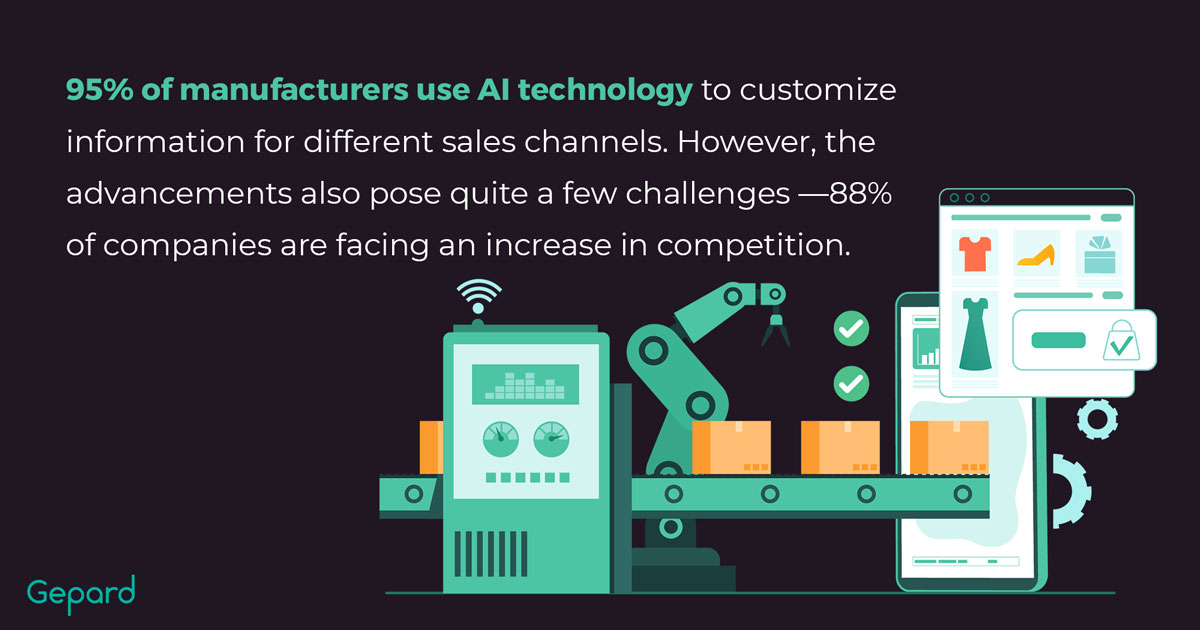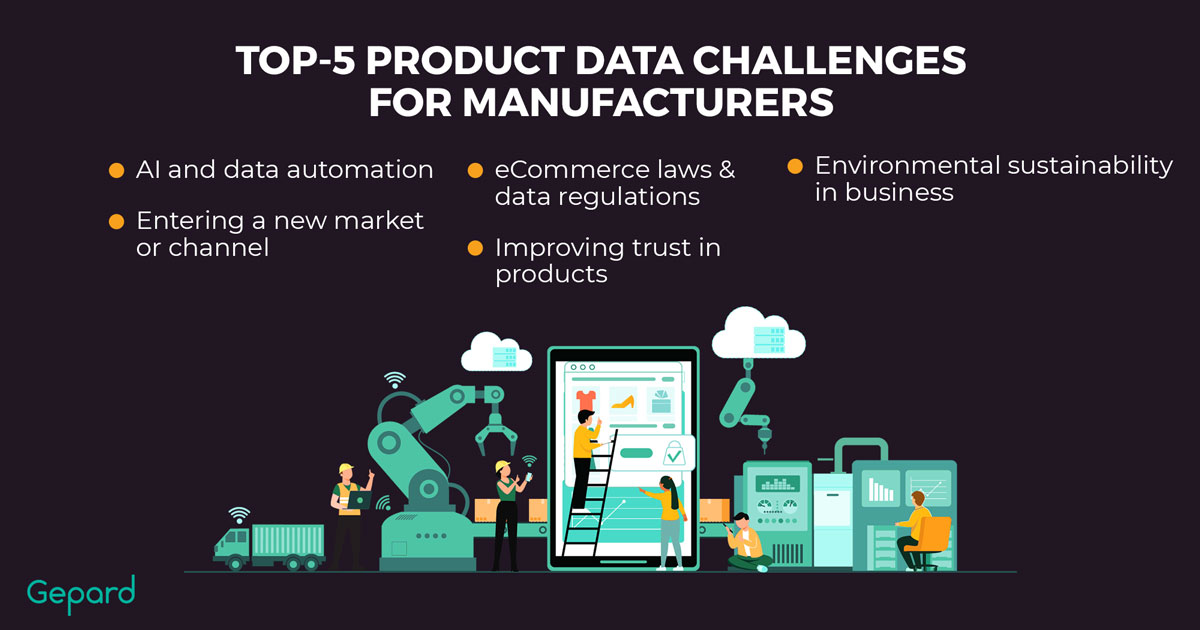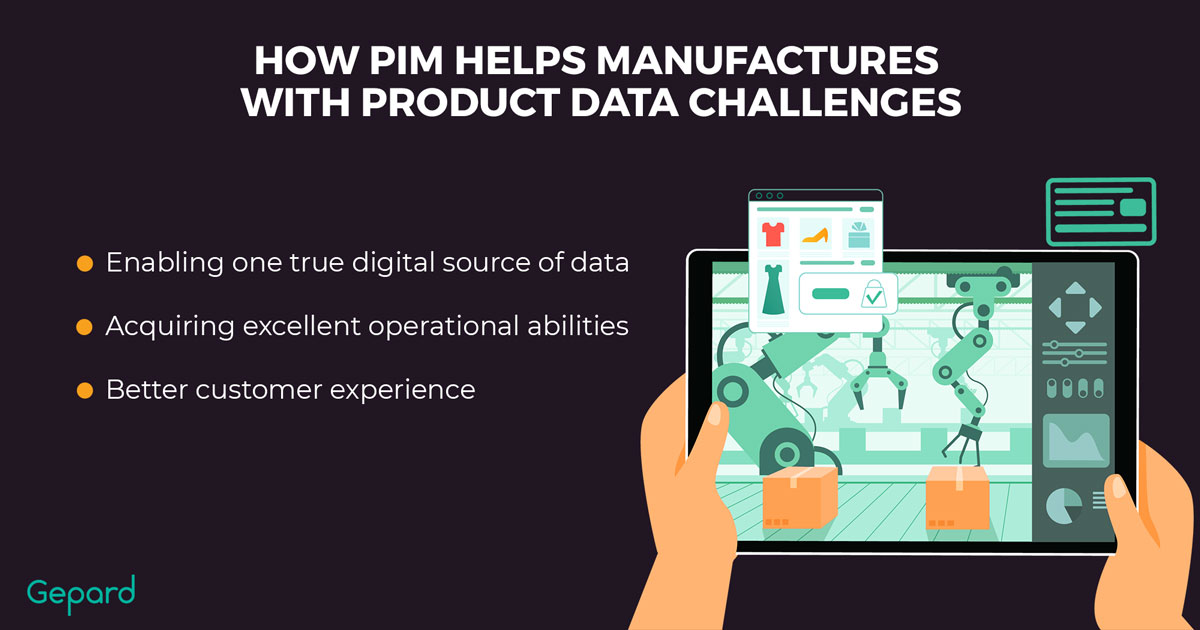TOP-5 Product Data Challenges For Manufacturers
While there’s always a demand for goods, customers also need high-quality data to decide whether they are going to buy any of the items you produce. But even with the highly technological digital commerce space, manufacturers face certain challenges in delivering on the market requirements.
Let’s discuss five of the most pressing challenges, starting with a definition of product data. We’ll also touch on how digitization has affected manufacturing businesses.
What Is Product Data?
Product Data For Manufacturers: Then And Now
It may seem that the best way to get a feel of an item is to go to a store and actually try it with your senses. But that was years ago when internet technology only started developing. The shopping experience with the first online stores wasn’t great — to put it mildly. No videos or images in presentable quality, and product information would come in Excel sheets. If you wanted to find out more about an item or buy it, you’d have to call the store.
Of course, eCommerce went through many trials and errors. But as with all technologies, it’s quickly transforming the way people shop and how manufacturing companies can deliver information about their stock to retailers.
Artificial intelligence (AI) and automation allow companies to get goods to the market much faster than before. For example, 95% of manufacturers use such technology to customize information for different sales channels. However, the advancements also pose quite a few challenges—88% of companies are facing an increase in competition—so let’s discuss them in greater detail.

TOP-5 Product Data Challenges For Manufacturers
Manufacturers deal with raw data that would hardly be useful to an average customer. It will go through stages of transformation before it becomes an entry in a product catalog and that’s where companies may hit a few roadblocks.
#1. AI And Data Automation
AI and automation have a large scope of use in digital commerce. AI algorithms can process massive volumes of data to help companies diagnose manufacturing equipment, control the production process, as well as automate mundane tasks. However, just over 50% of companies use AI solutions. It’s often that SMBs find it challenging to finance automation or lack the knowledge of using AI-enabled tools.
How to solve the challenge?
- Learn more about the benefits of AI and automation;
- Implement affordable AI and automation solutions;
- Provide training and support for using AI-enabled tools;
- Collaborate with technology partners;
- Develop a roadmap for AI and automation adoption.
Read more about AI in eCommerce:
#2. Entering A New Market Or Channel
The internet helps blur the national borders – market, sell, and ship items to other countries, not just cities within your homeland. This is partly facilitated by global eCommerce platforms like Amazon, eBay, and AliExpress that allow the creation of custom shops, managing stock, setting up shipments, and using popular payment systems.
However, all platforms have different item templates. Take Amazon for example – you need to fit its categories no matter what your taxonomy is; there are also guidelines about the information that each description should contain. So, customizing product information for each would take a lot of time.
How to solve the challenge?
- Conduct market research to make informed decisions;
- Develop a strategy for entering the new market or channel;
- Customize product information;
- Establish distribution channels that are suitable for the new market or channel;
- Localize marketing efforts – translate marketing materials into the local language, create culturally appropriate messaging, and utilize local marketing channels;
- Monitor performance and make necessary adjustments to your strategy.
#3. eCommerce Laws & Data Regulations
Whether you sell locally or cross-border, any manufacturer will face a slew of laws and regulations issued by government authorities. And if you use third-party sales platforms, you should also comply with the rules set by them. This may mean providing retailers with registration certificates, trademark information, and copyrighted images.
How to solve the challenge?
- Conduct a thorough review of applicable laws and regulations;
- Develop a compliance program based on the review;
- Train employees on the compliance program;
- Use trusted third-party platforms that comply with applicable laws and regulations;
- Obtain necessary certifications and trademarks;
- Monitor compliance.
#4. Improving Trust In Products
Rich high-quality data is what helps customers make a purchasing decision. But, if the information on your website, eCommerce platforms, retailer stores, and other channels is not consistent across the board, the trust in your wares may suffer. A way to improve the situation is standardizing the records about your wares to one format.
How to solve the challenge?
- Standardize and provide detailed product information;
- Use customer reviews and ratings;
- Implement quality control measures;
- Offer warranties and guarantees;
- Be transparent with your customers.
#5. Environmental Sustainability In Business
Sustainability is not a buzzword anymore with customers being more conscious about the packaging, resourcing, and manufacturing practices, as well as where returned items will end up (in a resale or on a landfill). For manufacturers, this means incorporating sustainable processes into the business but also making sure it reflects in product descriptions.
How to solve the challenge?
- Conduct a sustainability audit and develop a sustainability strategy;
- Use sustainable materials;
- Implement sustainable manufacturing processes;
- Incorporate sustainability into product descriptions.
The challenges have a lot to do with managing information. Of course, doing this manually would waste a lot of time and financial resources. That’s where product management (PIM) software comes in.

Product Data Management Best Practices For Manufacturers
Product Data Management (PDM) is a critical process for manufacturers to ensure that their products are effectively managed throughout their lifecycle. Here are some best practices that manufacturers can follow for effective PDM.
- Establish Data Governance Policies. It is important to define data governance policies and processes for managing product data. This includes standardizing data naming conventions, product classifications, data ownership, and data security.
- Centralize Data. Centralizing product data in a single repository helps manufacturers to have complete control over product information. This ensures that all product data is up-to-date, accurate, and easily accessible to all stakeholders.
- Standardize Product Data Formats. Standardizing product data formats helps to ensure that data can be easily shared across different systems and platforms. This includes standardizing product attributes, units of measurement, and product descriptions.
- Implement Data Validation and Quality Checks. Manufacturers should implement data validation checks and quality controls at every stage of the product lifecycle to ensure data accuracy and completeness.
- Utilize PDM Software. Management of data products automates processes, reduces data duplication and errors, and enables real-time access to product data. This helps to streamline workflows, improve collaboration, and increase productivity.
- Leverage Digital Asset Management (DAM). Digital Asset Management enables manufacturers to distribute and manage data about products such as images, videos, and other digital content easily. This improves the consistency of product information across multiple channels, such as websites, product catalogs, and social media.
- Ensure Data Security. Manufacturers need to ensure that their product data is secure and protected from unauthorized access, modification, or deletion. This includes implementing data access controls, backup and recovery procedures, and disaster recovery plans.
- Regular Data Audits. Regular audits of product data are important to ensure that product information is accurate, up-to-date, and consistent across all channels.
How PIM Helps Manufactures With Product Data Challenges
PIM is a system that helps structure data, enrich descriptions, and distribute this information across different sales channels. In terms of challenges, it can help you in the following ways.
Enabling One True Digital Source Of Data
A PIM system allows you to create a single source of product information from all product data sources that you can manage, alter, and overall create an omnichannel experience for individual customers and other businesses.
You can import data into PIM software, enrich it with quality information, integrate it with digital data assets, and automatically check for inconsistencies. The system will also customize the descriptions and attributes in accordance with a predefined set of rules to fit product catalog templates of the platforms you’re using, like Amazon.
Most importantly, if the data assets require any changes, you will have to edit it only in one source — your PIM system — and the changes will be distributed to all preferred channels. So you don’t need to work on one platform at a time.
Acquiring Excellent Operational Abilities
A PIM system provides a simple way of formatting data and publishing ready descriptions to different channels. This is more efficient because the software can perform multiple activities (processing and distribution) at the same time. It also automates repetitive processes like syndicating data after description or other asset changes.
As such, it can minimize the time to market and boost customer satisfaction thanks to the above-mentioned features as they provide consistency and a more holistic view of any item you produce. It can also free up your team from routine work so there’s more time for creativity and strategic planning.
Digital Shelf Data Analytics
With this audit feature, offered by a flexible PIM system, you can easily supervise the content, covered by content providers and control the quality of your enriched product listings on content providers’ websites.
It gives you a guarantee of always accurate and constantly updated product content. Moreover, it’s a real-time saver for product brands and manufacturers that produce many goods but cannot afford to manually track the data quality and completeness of their data posted on multiple sales channels and content providers. With the automation, offered by PIM, these routine tasks can be performed automatically while you can focus on more important tasks that require the creativity of your employees.
Better Customer Experience
PIM is a McDonald’s of sorts – wherever you travel, you can go to a Golden Arches spot and expect the same taste and services as at home. Same with using a PIM – it standardizes information so that you can deliver the most up-to-date information, and customers can expect the same data quality of data whether they visit your online shop or an Amazon store.
Thanks to AI and other technology, a PIM can help you structure data in a way that facilitates personalization. A PIM also ensures that the information across your channels is updated so customers get the most current information and more likely – the product they expected. This way you can provide more value to customers and improve their shopping experience.

Product Data FAQ
Why Does Manufacturing Product Data Management Matter?
It matters because the market demands high volumes of data that can provide customers with a holistic view of any given product. This is possible if you centralize product management, including information management in a PIM system that allows keeping current information and synchronizing it across multiple channels.
Which Manufacturers Need A PIM?
Most manufacturers need a PIM system to automate routine processes and centralize data management. But such software will be more relevant and efficient if you operate with more than a hundred products, you regularly update your catalog of goods, and you require language localization. It’s also relevant for companies where the team can be involved in more creative or strategic tasks since the software will save time on routine tasks.
Read about the advantages and disadvantages of PIM solutions for brands:
What Does A PIM System Really Cost?
A PIM can cost you all the way up to $250K a year. There are free tools as well, though they probably won’t fully support the size of your production, and the features and integrations you need.
PIM prices vary because there are on-time (setting up, implementing, or developing the system) and ongoing costs, such as hosting and maintaining the software. The final price also depends on your industry, how much data there is to manage, the number of sales channels, and of course functional requirements.
Manage Manufacturing Product Data With Gepard PIM
Manufacturers deal with volumes of data and a heap of routing tasks when it comes to information. While AI and data automation can help process information faster, SMBs may find it difficult to finance more complex software. Selling globally can also be a challenge because you need to comply with local laws, on the one hand, and with eCommerce platform guidelines, on the other. All the while providing exceptional service to your customers.
That’s why using a PIM system, such as Gepard PIM, is essential. It’s a single source of information that you can fill, edit, and then automatically distribute to all your channels. On top of that, you can easily monitor your digital shelf and be sure that you’re getting the most out of all the product data distributed via PIM software. It also helps automate routine tasks so you can deliver products to market much faster.
Gepard PIM helps standardize and validate the data, keep it current across all your channels, and enrich it with quality. This results in a shorter time to market, higher sales, and improved customer satisfaction.
Contact us to discover more capabilities of Gepard PIM that can benefit your business.





